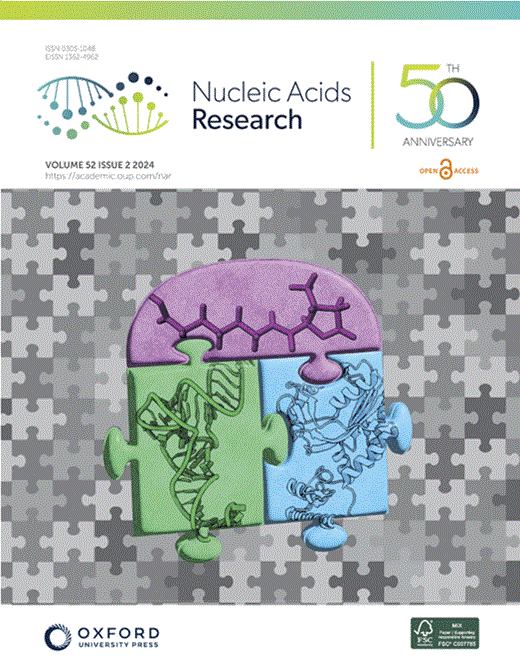SARS-CoV-2点突变在RNA茎环结构的末端环中有过多的表现,这些突变可以通过Nsp13解旋酶以核苷酸依赖的独特方式解决。
IF 16.6
2区 生物学
Q1 BIOCHEMISTRY & MOLECULAR BIOLOGY
引用次数: 0
摘要
为了改善COVID-19(冠状病毒病2019)患者的健康结果,需要确定影响冠状病毒基因组变异的因素。SARS-CoV-2(严重急性呼吸综合征冠状病毒2)基因组富含可预测的RNA二级结构,特别是由回文序列内分子内碱基配对形成的茎环(SLs)。我们分析了来自COVID-19个体的NCBI病毒收集的SARS-CoV-2基因组序列,以绘制与SL结构元件相关的变异。SARS-CoV-2基因组中的点突变,具有从c到u的过渡偏倚,在未配对的核苷酸中,更具体地说,在RNA SL结构的末端环中,被过度代表。作为SARS-CoV-2唯一编码的解旋酶,Nsp13可能在及时分解次级RNA结构中起作用,促进SARS-CoV-2 RNA的复制或加工。我们鉴定了Nsp13能够分解SARS-CoV-2序列衍生的单分子RNA SL底物,并确定它以功能合作的方式这样做。除了ATP外,Nsp13还能在缺少核苷酸的情况下分解单分子RNA SL结构,这与双分子RNA分叉双链对ATP的严格要求形成了鲜明对比。我们提出了一个模型,在该模型中,Nsp13与核苷酸和/或RNA SL的一系列二元和三元复杂相互作用对RNA SL的解析具有机制意义。本文章由计算机程序翻译,如有差异,请以英文原文为准。
SARS-CoV-2 point mutations are over-represented in terminal loops of RNA stem-loop structures that can be resolved by Nsp13 helicase in a unique manner with respect to nucleotide dependence.
To improve health outcomes for COVID-19 (coronavirus disease 2019) patients, the factors that influence coronavirus genome variation need to be ascertained. The SARS-CoV-2 (severe acute respiratory syndrome coronavirus 2) genome is rich in predicted RNA secondary structures, particularly stem-loops (SLs) formed by intramolecular base pairing within palindromic sequences. We analyzed the NCBI Virus collection of SARS-CoV-2 genome sequences from COVID-19 individuals to map variants relative to SL structural elements. Point mutations in the SARS-CoV-2 genome, with a C-to-U transition bias, were over-represented in unpaired nucleotides and, more specifically, within the terminal loops of RNA SL structures. As the sole helicase encoded by SARS-CoV-2, Nsp13 may operate in the timely resolution of secondary RNA structures to facilitate SARS-CoV-2 RNA copying or processing. We characterized Nsp13 to resolve SARS-CoV-2 sequence-derived unimolecular RNA SL substrates and determined that it does so in a functionally cooperative manner. In addition to ATP, Nsp13 resolves the unimolecular RNA SL structure in the absence of nucleotide, in contrast to the strict ATP requirement for a bimolecular RNA forked duplex. We suggest a model in which a series of binary and ternary complex interactions of Nsp13 with nucleotide and/or RNA SL pose mechanistic implications for RNA SL resolution.
求助全文
通过发布文献求助,成功后即可免费获取论文全文。
去求助
来源期刊

Nucleic Acids Research
生物-生化与分子生物学
CiteScore
27.10
自引率
4.70%
发文量
1057
审稿时长
2 months
期刊介绍:
Nucleic Acids Research (NAR) is a scientific journal that publishes research on various aspects of nucleic acids and proteins involved in nucleic acid metabolism and interactions. It covers areas such as chemistry and synthetic biology, computational biology, gene regulation, chromatin and epigenetics, genome integrity, repair and replication, genomics, molecular biology, nucleic acid enzymes, RNA, and structural biology. The journal also includes a Survey and Summary section for brief reviews. Additionally, each year, the first issue is dedicated to biological databases, and an issue in July focuses on web-based software resources for the biological community. Nucleic Acids Research is indexed by several services including Abstracts on Hygiene and Communicable Diseases, Animal Breeding Abstracts, Agricultural Engineering Abstracts, Agbiotech News and Information, BIOSIS Previews, CAB Abstracts, and EMBASE.
 求助内容:
求助内容: 应助结果提醒方式:
应助结果提醒方式:


